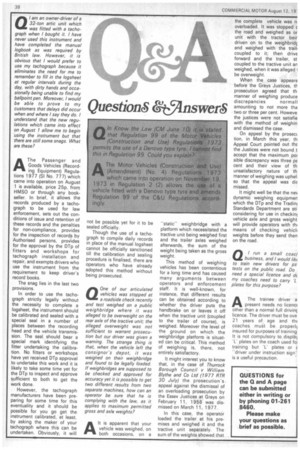Q 0ne of our articulated vehicles was stopped at a roadside
Page 40

If you've noticed an error in this article please click here to report it so we can fix it.
check recently and test weighed on a public weighbridge where it was alleged to be overweight on the rear axle of the tractive unit; the alleged overweight was not sufficient to warrant prosecution but our driver was given a warning. The strange thing is that, when the vehicle left the consignor's depot, it was weighed on their weighbridge and found to be legally loaded. If weighbridges are supposed to be checked and approved for accuracy yet it is possible to get two different results from two separate machines, how can an operator be sure that he is complying with the law, as it applies to maximum permitted gross and axle weights?
AIt is apparent that your vehicle was weighed, on both occasions, on a
"static" weighbridge with a platform which necessitated the tractive unit being weighed first and the trailer axles weighed afterwards, the sum of the weight being taken as the gross weight.
This method of weighing vehicles has been contentious for a long time and has caused many arguments between operators and enforcement staff. It is well-known, for instance, that different results can be obtained according to whether the driver puts the handbrake on or leaves it off when the tractive unit (coupled to the trailer of course), is weighed. Moreover the level of the ground on which the weighbridge platform is situated can be critical. This method of weighing is, there, not entirely satisfactory.
It might interest you to know that, in the case of Thurrock Borough Council v William Blythe and Co Ltd (1977 RTR 30 July) the prosecution's, appeal against the dismissal of an overloading prosecution by the Essex Justices at Grays on February 11, 1956 was dismissed on March 11, 1977.
In this case, the operator loaded the trailer at his premises and weighed it and the tractive unit separately. The sum of the weights showed that the complete vehicle was n overloaded. It was stopped c the road and weighed as or unit with the tractor beir driven on to the weighbridc and weighed with the trail, coupled to it; then drivE forward and the trailer, st coupled to the tractive unit an weighed, when it was alleged ^ be overweight.
When the case appeare before the Grays Justices, if prosecution agreed that th manner of weighing produce discrepancies normal' amounting to not more tha two or three per cent. Howeve the justices were not satisfie with the method of weighin and dismissed the case.
On appeal by the proseci tion, in March this year, th Appeal Court pointed out thE the Justices were not bound t accept that the maximum pot sible discrepancy was three pE cent and their view of th unsatisfactory nature of th manner of weighing was uphell so that the appeal was di: missed.
It might well be that the ne‘ dynamic weighing equipmen which the Dip and the Tradin, Standards Department are sti considering for use in checkint vehicle axle and gross weight will provide operators with th, means of checking vehich weights before they send then on the road.




















































































